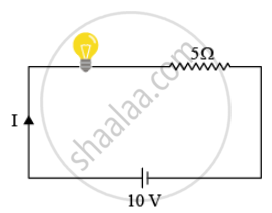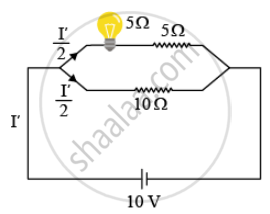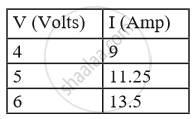Advertisements
Advertisements
प्रश्न
A current of 1 ampere flows in a series circuit containing an electric lamp and a conductor of 5 Ω when connected to a 10 V battery. Calculate the resistance of the electric lamp.
Now if a resistance of 10 Ω is connected in parallel with this series combination, what change (if any) in current flowing through 5 Ω conductor and potential difference across the lamp will take place? Give reason.
उत्तर
Let the resistance of the electric lamp be Rlamp.
Current (I) = 1 A
Resistance of conductor (Rconductor) = 5Ω
Potential difference of battery (V) = 10 V

Since the lamp and the conductor is connected in series, thus same current 1 A will pass through both of them.
Using Ohm's law,
`"R"_"net" = "V"/"I"`
`"R"_"net" = 10/1`
`"R"_"net" = 10`Ω
`"R"_"net" = "R"_"lamp" + "R"_"conductor"`
⇒ 10 = Rlamp + 5
⇒ Rlamp = 5Ω
Potential difference across lamp,
Vlamp = I × Rlamp = 1 × 5 = 5V
When 10Ω resistor is connected parallel to the series combination of lamp and conductor (Rnet = 5 + 5 = 10Ω) then the equivalent resistance,

`1/("R"_"eq") = 1/10 + 1/10 = 2/10 =1/5`
⇒ Req = 5Ω
Using Ohm's law
`"I"^"'" = "V"/"R"_"eq"`
⇒ `"I"^"'" = 10/5`
⇒ `"I"^"'" = 2 "A"`
Current will distribute equally in two parallel parts.
Thus, `"I"^"'"/2 = 1"A"` current will pass through both the lamp and the resistor of 5Ω (because they are connected in series).
Potential difference across the lamp (Rlamp) = 5Ω
`"V"_"lamp"^"'" = 1 xx 5 = 5"V"`
Hence, there will be no change in current through the conductor of resistance 5Ω, and potential difference across the lamp.
APPEARS IN
संबंधित प्रश्न
What do you understand by the term "potential difference"?
A resistance of 20 ohms has a current of 2 amperes flowing in it. What potential difference is there between its ends?
The potential difference between the terminals of an electric iron is 240 V and the current is 5.0 A. What is the resistance of the electric iron?
A p.d. of 10 V is needed to make a current of 0.02 A flow through a wire. Wire p.d. is needed to make a current of 250 mA flow through the same wire?
The following table shows current in Amperes and potential difference in Volts.
What will be the nature of the graph between the current and potential difference? (Do not draw a graph.)

Three electric cells of potential difference 1.5 V each have been connected as a battery. The potential differences of the battery will be ____________ V.
Point out two differences between e.m.f. and potential difference as applied to electric circuits.
How will you conclude that the same potential difference (voltage) exists across three resistors connected in a parallel arrangement to a battery?
Name a device that helps to maintain a potential difference across conductors.
Twenty-seven drops of same size are charged at 220 V each. They combine to form a bigger drop. Calculate the potential of the bigger drop.
